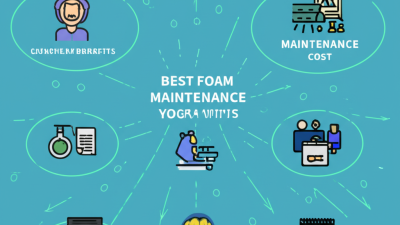The market for Foam Yoga Mats has seen significant growth, with an estimated expansion rate of 5.4% annually according to a recent report by Grand View Research. As wellness and fitness trends continue to rise, particularly in the post-pandemic era, understanding the aftersales benefits and maintenance costs associated with Foam Yoga Mats becomes crucial for consumers and retailers alike.

Quality materials and innovative features, such as eco-friendliness and grip technology, not only enhance user experience but also impact the longevity and lifecycle costs of these products. Exploring various types of Foam Yoga Mats can help buyers determine which options best suit their needs, while also considering the value of ongoing maintenance and support services.
By delving into these aspects, this blog aims to provide insights that aid consumers in making informed decisions in this competitive market.
Comprehensive aftersales services play a crucial role in enhancing customer satisfaction and loyalty in the foam yoga mat industry. According to a recent industry report by IBISWorld, the global market for yoga mats is projected to grow by 4.5% annually, highlighting the increasing competition that brands face. Offering robust aftersales support, such as warranties and repair services, not only helps in retaining customers but also encourages them to recommend products to others, effectively increasing brand visibility.
TIP: Ensure to utilize online platforms for customer feedback collection. This can provide valuable insights into consumer preferences, enabling brands to enhance their aftersales services.
Maintenance costs are also significantly impacted by the quality of aftersales services. A study published in the Journal of Product & Brand Management indicates that customers who receive ongoing support for product care report lower maintenance costs over time. For foam yoga mats, offering maintenance tips, such as proper cleaning methods and storage solutions, can prolong the product's lifespan and reduce long-term costs for users.
TIP: Consider including a detailed care guide with each product purchase to educate customers on extending the life of their yoga mats, which can lead to positive reviews and repeat purchases.
| Benefit | Description | Estimated Maintenance Cost (Annual) | Customer Satisfaction Rating (1-5) |
|---|---|---|---|
| Durability Guarantee | Extended warranty covering foam integrity and wear. | $10 | 4.8 |
| Free Replacement Program | Free replacement for defects within the first year. | $0 | 4.9 |
| Eco-Friendly Disposal | Guidance on recycling or disposing of old mats responsibly. | $5 | 4.7 |
| Cleaning and Care Tips | Access to expert advice on maintaining mat quality. | $3 | 4.6 |
| Loyalty Discounts | Discounts on future purchases for returning customers. | $15 | 4.5 |
When it comes to maintaining your foam yoga mat, proper care can significantly reduce maintenance costs and prolong its lifespan. One of the simplest yet most effective tips is to clean your mat regularly. Use a gentle soap and warm water solution to wipe down the surface after each use. This practice helps prevent the buildup of sweat and bacteria, which can degrade the material over time. Additionally, always ensure your mat is fully dry before rolling it up to avoid any moisture-related issues.
Another essential maintenance tip is to store your foam yoga mat properly. Avoid placing it in direct sunlight, as UV rays can cause fading and deterioration. Instead, keep it in a cool, dry place. Using a mat carrier or strap not only makes transportation easier but also helps maintain its shape, preventing creases and uneven wear. By following these simple care routines, enthusiasts can enjoy their foam yoga mats longer while minimizing costs associated with replacements and repairs.
When considering the purchase of foam yoga mats, understanding warranty options is crucial to enhance customer satisfaction. A comprehensive warranty not only protects your investment but also provides peace of mind, knowing you’re covered against defects and premature wear. In fact, studies show that products backed by solid warranties can improve customer loyalty by up to 35%. This is particularly relevant for foam yoga mats, which can often experience wear and tear from regular use.
Tips for choosing the right warranty include checking the coverage period and the types of damages covered. Opt for warranties that offer replacement options if the mat deteriorates unusually quickly. Additionally, look for manufacturers that provide clear communication regarding claims processes, as transparency can significantly affect customer experience.
Another valuable tip is to consider customer reviews and satisfaction ratings for the brand before making a purchase. Much like home warranty services, customer feedback on the responsiveness of warranty claims can highlight which companies prioritize their customers’ needs. Ensuring that your yoga mat purchase comes with a robust warranty can lead to enhanced satisfaction and trust in the brand, positioning you well for future purchases.
When it comes to maintaining the optimal performance of foam yoga mats, a few common repair issues can arise over time. One of the most frequent problems is the formation of tears or rips due to heavy use. To address this issue, yoga practitioners can easily repair their mats at home using strong adhesive patches specifically designed for foam materials. Applying these patches not only seals the damage but also extends the life of the mat, ensuring that it remains a reliable practice tool.
Another common concern is the wear and tear of the mat’s surface, which can lead to decreased grip and stability during practice. Regular cleaning with mild soap and water can help to rejuvenate the mat's surface, but if it becomes excessively worn, a DIY solution is to use a thin layer of a non-toxic sealant that can restore the texture and increase grip. This approach provides an economical way to keep yoga mats functional without the need for costly replacements, making it an ideal option for yogis looking to preserve their equipment while reducing overall maintenance costs.
Investing in quality foam yoga mats can significantly enhance your practice and offer long-term value. While cheaper options may save you money upfront, they often lack durability and comfort, leading to more frequent replacements. A high-quality mat provides better cushioning and grip, which can improve your overall experience and reduce the risk of injuries. By choosing a reliable brand, you’re not just buying a mat; you’re investing in a supportive tool that will aid your growth in yoga.
**Tip: When selecting a yoga mat, look for materials that are eco-friendly and free from harmful chemicals. This not only benefits your health but also contributes to a sustainable environment.**
Another crucial aspect to consider is the aftersales service and maintenance of your yoga mat. A reputable brand often provides guidance on proper care, which can prolong the lifespan of your mat. Regular cleaning, proper storage, and using appropriate props can keep your mat in excellent condition, enhancing its performance over time.
**Tip: Use a gentle cleaner to wipe down your mat after classes to prevent wear and tear, ensuring it remains hygienic and vibrant for years to come.**
